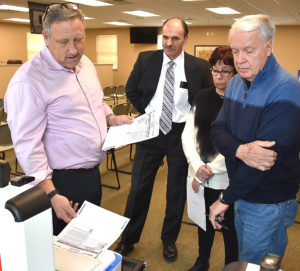Rest assured your vote will count in next month’s election. The Grand Rapids-based company Election Source spent Jan. 28 in Oxford Township’s meeting room testing the voting machines that will be used in Oxford’s March 10 presidential primary.
The township election commission signed off on a legally-required public accuracy test conducted in the afternoon. Election Source vice president Steve DeLongchamp demonstrated the test for Township Clerk Curtis Wright and Trustees Patti Durr and Elgin Nichols, who make up the election commission.
It is a closed primary, so voters must choose whether to vote on a Republican or Democratic ballot, but not both. An

uncommitted ballot containing only the proposed DIA (Detroit Institute of Arts) millage renewal will also be available.
A sample deck of Republican ballots was used for the test. The deck included a staggered total of six ballots for Donald Trump, five for Joe Walsh, four for Bill Weld, three for Mark Sanford, two for an uncommitted candidate and one for a write-in candidate. The deck also included “problem ballots” including a ballot with stray marks, a blank ballot, an overvoted ballot, and a ballot from the wrong precinct.
DeLongchamp fed the ballots individually through one of the Verity Scan tabulators, which counted the votes, scanned the ballots and rejected the “problem ballots.”
“Everything’s working like it should,” DeLongchamp confirmed.
The Republican deck was chosen only because with fewer candidates it is much shorter than the Democratic deck. In order to get the required staggered totals, the Republican deck was 26 ballots while the Democratic deck was 158.
The Democratic decks were tested earlier in the day. Each deck was tested multiple times on each machine. “That’s done for everything,” DeLongchamp said. “For absentees and regular tabulators. Everything has to be tested.”
They also tested the township’s Touch Writer machines which make voting easier for people with disabilities. The Touch Writers print a regular ballot, then those ballots must still be fed through the tabulators in order to be counted.
Election Source will be back to test the machines again before the next primary election in August and again before the general election in November.

Leave a Reply